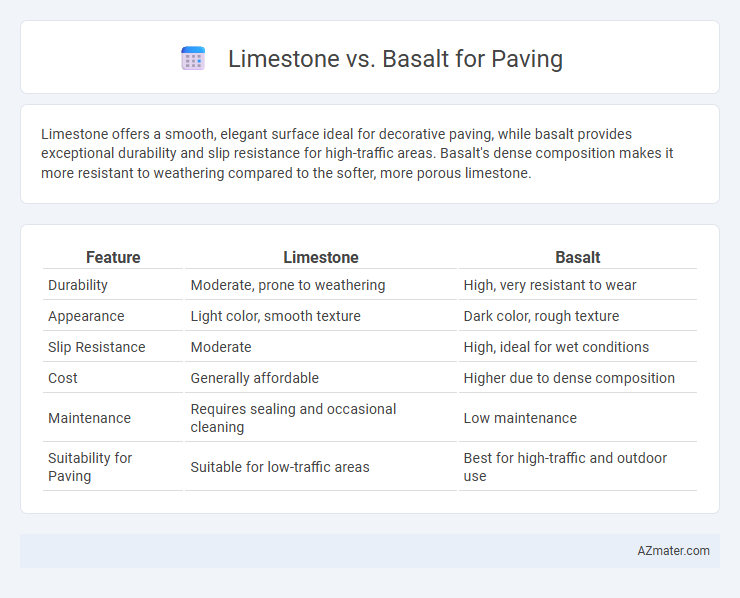Limestone offers a smooth, elegant surface ideal for decorative paving, while basalt provides exceptional durability and slip resistance for high-traffic areas. Basalt's dense composition makes it more resistant to weathering compared to the softer, more porous limestone.
Table of Comparison
| Feature | Limestone | Basalt |
|---|---|---|
| Durability | Moderate, prone to weathering | High, very resistant to wear |
| Appearance | Light color, smooth texture | Dark color, rough texture |
| Slip Resistance | Moderate | High, ideal for wet conditions |
| Cost | Generally affordable | Higher due to dense composition |
| Maintenance | Requires sealing and occasional cleaning | Low maintenance |
| Suitability for Paving | Suitable for low-traffic areas | Best for high-traffic and outdoor use |
Introduction to Limestone and Basalt
Limestone is a sedimentary rock primarily composed of calcium carbonate, renowned for its light color and smooth texture, making it popular in decorative paving. Basalt, an igneous rock formed from cooled lava, features a dark color and fine-grained texture, offering exceptional durability and slip resistance. Both materials provide distinct aesthetic and functional benefits for paving applications depending on design and environmental needs.
Geological Origins and Composition
Limestone is a sedimentary rock primarily composed of calcium carbonate formed from marine organisms' skeletal fragments, resulting in its softer, porous texture ideal for decorative paving. Basalt, an extrusive igneous rock, originates from rapid cooling of lava rich in iron and magnesium, making it dense, hard, and highly durable for heavy-traffic paving applications. The mineral composition differences between calcium carbonate in limestone and silicate minerals in basalt directly influence their weathering resistance and surface finish qualities.
Visual Differences: Color and Texture
Limestone and basalt present distinct visual differences in color and texture for paving applications. Limestone typically features light, neutral tones such as beige, cream, and pale gray with a smooth, fine-grained texture that offers a classic and elegant appearance. Basalt displays darker hues ranging from charcoal black to deep gray, accompanied by a dense, fine-grained, and slightly rough texture that creates a bold, modern aesthetic for outdoor surfaces.
Durability and Weather Resistance
Limestone offers moderate durability with a softer composition prone to erosion and weathering, making it less ideal for high-traffic paving areas exposed to harsh climates. Basalt, known for its dense, fine-grained volcanic structure, exhibits superior durability and excellent resistance to abrasion, freeze-thaw cycles, and chemical weathering, ensuring long-lasting performance. For paving projects requiring resilience against weather extremes and heavy use, basalt provides a robust solution compared to limestone.
Slip Resistance and Safety
Limestone offers moderate slip resistance with a textured surface that performs well in dry conditions but can become slippery when wet, making it less ideal for high-traffic or wet areas. Basalt provides superior slip resistance due to its naturally rough and dense surface, enhancing safety in both dry and wet environments. Choosing basalt for paving ensures better traction and reduces slip hazards, especially in public or outdoor spaces prone to moisture.
Maintenance Requirements
Limestone requires regular sealing and occasional repairs due to its porous nature and susceptibility to staining, making maintenance more intensive compared to basalt. Basalt is highly durable and dense, offering superior resistance to weathering, abrasion, and staining, which reduces the frequency and cost of upkeep. Choosing basalt for paving minimizes long-term maintenance efforts and enhances surface longevity in high-traffic environments.
Cost Comparison
Limestone paving generally costs between $5 to $10 per square foot, making it more affordable than basalt, which ranges from $8 to $15 per square foot due to its higher density and durability. Installation expenses for basalt are typically higher because of its hardness, requiring specialized equipment and labor. For budget-conscious projects, limestone offers a cost-effective option without compromising aesthetic appeal, whereas basalt provides a longer lifespan that can offset its initial investment over time.
Environmental Impact and Sustainability
Limestone is a sedimentary rock with a lower carbon footprint due to its abundant availability and ease of extraction, making it a more sustainable option for paving compared to basalt. Basalt, an igneous rock, requires higher energy consumption during quarrying and processing because of its hardness and density, increasing its environmental impact. Both stones are durable for paving, but limestone's lower energy demands and natural recyclability contribute to better long-term sustainability.
Popular Applications in Paving
Limestone is widely used in paving for its smooth texture and warm, natural colors, making it ideal for patios, walkways, and driveways in residential and commercial projects. Basalt is favored for high-traffic areas due to its durability, density, and resistance to wear, commonly seen in urban plazas, streetscapes, and industrial pavements. Both materials offer distinct aesthetic and functional benefits, with limestone providing elegance and basalt ensuring longevity in demanding paving applications.
Choosing the Right Stone for Your Project
Limestone offers a smooth texture and light color ideal for elegant, heat-reflective paving projects in warmer climates, while basalt provides exceptional durability and a dark tone suitable for high-traffic or industrial areas. Selecting the right stone depends on factors like weather resistance, slip resistance, and aesthetic preference; limestone is porous and requires sealing to prevent staining, whereas basalt's dense composition withstands heavy wear and resists moisture. Balancing maintenance requirements with environmental conditions ensures the chosen paving material delivers long-lasting performance and desired visual appeal.

Infographic: Limestone vs Basalt for Paving
 azmater.com
azmater.com